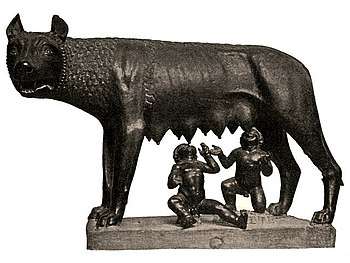Frogs in culture
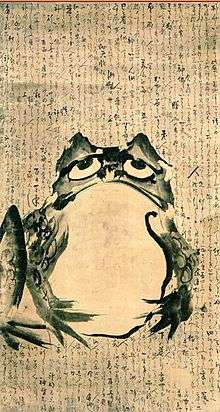
Frogs play a variety of roles in culture, appearing in folklore and fairy tales such as the Brothers Grimm story of The Frog Prince. In ancient Egypt and Mesopotamia, frogs symbolized fertility, while in classical antiquity, the Greeks and Romans associated frogs with fertility, harmony, and licentiousness.
Frogs are the subjects of fables attributed to Aesop, of proverbs in various cultures, and of art. Frog characters such as Kermit the frog feature in popular culture. They are eaten in some parts of the world including France. In Australia, a fondant dessert is known as frog cake.
History
Ancient Mesopotamia
In the Sumerian epic poem of Inanna and Enki, the goddess Inanna tricks Enki, the god of water, into giving her all of the sacred mes,[1] prompting Enki to send various watery creatures to retrieve them.[1] The first of these is a frog, whom Enki grasps "by its right hand".[1] Frogs also appear as filling motifs on cylinder seals of the Kassite Period.[1]
Ancient Egypt
To the Egyptians, the frog was a symbol of life and fertility, since millions of them were born after the annual flooding of the Nile, which brought fertility to the otherwise barren lands. Consequently, in Egyptian mythology, there began to be a frog-goddess, who represented fertility, named Heqet. Heqet was usually depicted as a frog, or a woman with a frog's head, or more rarely as a frog on the end of a phallus to explicitly indicate her association with fertility.[2] A lesser known Egyptian god, Kek, was also sometimes shown in the form of a frog.[3]
Texts of the Late Period describe the Ogdoad of Hermepolis, a group of eight "primeval" gods, as having the heads of frogs (male) and serpents (female), and they are often depicted in this way in reliefs of the Greco-Roman period.[4] The god Nu in particular is sometimes depicted either with the head of a frog surmounted by a beetle.[3]
Hapi was a deification of the annual flood of the Nile River, in Egyptian mythology, which deposited rich silt on the banks, allowing the Egyptians to grow crops. In Lower Egypt, he was adorned with papyrus plants, and attended by frogs, present in the region, and symbols of it.[5]
Classical antiquity
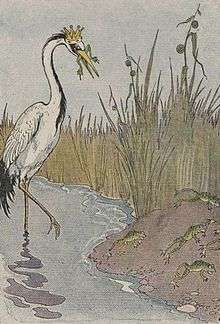
The Greeks and Romans associated frogs with fertility and harmony, and with licentiousness in association with Aphrodite.[2] The combat between the Frogs and the Mice (Batrachomyomachia) was a mock epic, commonly attributed to Homer, though in fact a parody of his Iliad.[6][7][8] The Frogs Who Desired a King is a fable, attributed to Aesop. The Frogs prayed to Zeus asking for a King. Zeus set up a log to be their monarch. The Frogs protested they wanted a fierce and terrible king, not a mere figurehead. So Zeus sent them a Stork to be their king. The new king hunted and devoured his subjects. Aesop wrote a fable about a frog trying to inflate itself to the size of an ox. Phaedrus (and later Jean de La Fontaine) wrote versions of this fable. The Frogs is a comic play by Aristophanes, in which the choir of frogs sings the famous onomatopoeic line: "Brekekekex koax koax."[9]
In the Bible, the Second Plague of Egypt described in the Book of Exodus 8:6 is of frogs. In the New Testament, frogs are associated with unclean spirits in Revelation 16:13.[2]
Medieval and Early Modern
Medieval Christian tradition based on the Physiologus distinguished land frogs from water frogs representing righteous and sinful congregationists, respectively. In folk religion and occultism, the frog also became associated with witchcraft or as an ingredient for love potions.[10]
The Japanese poet Matsuo Bashō wrote one of his most famous haikus about a frog jumping into an old pond.[11]
In modern culture
Proverbs and popular traditions
The "frog in a well" saying about having a narrow vision of life is found in Sanskrit ("Kupa Manduka", कुपमन्डुक),[12] in Bengali, কুপমন্ডুক), in Vietnamese "Ếch ngồi đáy giếng coi trời bằng vung" ("Sitting at the bottom of wells, frogs think that the sky is as wide as a lid"), and in Malay "Bagai katak dibawah tempurung" ("Like a frog under a coconut shell").. The Chinese versions are "坐井觀天" ("sitting in the well, looking to the sky") and "井底之蛙" ("a frog in a well") from the Taoist classic Zhuangzi that has a frog living in an abandoned well, who talks about things big and small with the turtle of the Eastern Sea.[13]
Other frog proverbs include the American "You can't tell by looking at a frog how high he will jump." and the Iranian "When the snake gets old, the frog gets him by the balls."[14]
In Chinese traditional culture, frog represents the lunar yin, and the Frog spirit Ch'ing-Wa Sheng is associated with healing and good fortune in business, although a frog in a well is symbolic of a person lacking in understanding and vision.[2]
The supposed behavior of frogs illustrating nonaction is told in the often-repeated story of the boiled frog: put a frog in boiling water and it will jump out, but put it in cold water and slowly heat it, and it will not notice the danger and will be boiled alive. The story was based on nineteenth century experiments in which frogs were shown to stay in heating water as long as it was heated very slowly.[15] The validity of the experiments is however disputed. Professor Douglas Melton, Harvard University Biology Department, says: "If you put a frog in boiling water, it won't jump out. It will die. If you put it in cold water, it will jump before it gets hot—they don't sit still for you."[16]
The short poem What a queer bird, which appeared in magazines in the 1920s, is about the qualities of a frog from a bird's perspective.[17][18][19]
In art
The Moche people of ancient Peru worshipped animals and often depicted frogs in their art.[20] Painters of the Dutch Golden Age sometimes included frogs in their compositions;[21] for example, Ambrosius Bosschaert II painted a vanitas still life Dead Frog with Flies c. 1630; in 2012, the artists Rob and Nick Carter created a silent digital version, lasting three hours, in which the "still" image "slowly, imperceptibly" changes with the movement of the sun, and occasionally an insect such as a dragonfly enters the scene.[22]
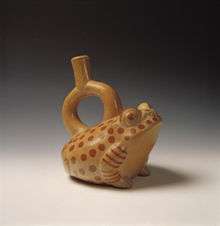 Moche frog, 200 AD
Moche frog, 200 AD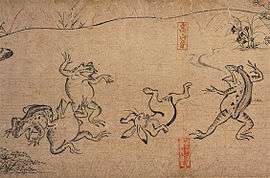 Wrestling frogs from Chōjū-jinbutsu-giga, cartoon, Japan, 12th century
Wrestling frogs from Chōjū-jinbutsu-giga, cartoon, Japan, 12th century Dead Frog with Flies by Ambrosius Bosschaert II, c. 1630
Dead Frog with Flies by Ambrosius Bosschaert II, c. 1630_(5172249722).jpg) Crapaud et Grenouille ("Frog and Toad") by Jean Carriès, between 1889 and 1894
Crapaud et Grenouille ("Frog and Toad") by Jean Carriès, between 1889 and 1894.jpg) Entre ciel et terre, by Gustave Doré, 1862
Entre ciel et terre, by Gustave Doré, 1862_-_Google_Art_Project.jpg) Hermenegildo Bustos, Still life with fruit, 1874
Hermenegildo Bustos, Still life with fruit, 1874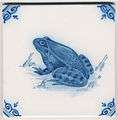 Old Dutch tile from Friesland
Old Dutch tile from Friesland
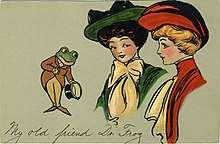
Contemporary pop culture
The theme of transformation features prominently in popular culture, from The Frog Prince to fantasy settings such as the Final Fantasy and Chrono Trigger video games with magic spells that turn people into frogs.[23]
Michigan J. Frog featured in a Warner Brothers cartoon.[24] Kermit the Frog is the straight man character in Sesame Street and The Muppet Show.[25]
Several Pokémon species are based on frogs and toads, such as the Poliwrath,[26] Politoed,[27] Seismitoad,[28] and Greninja[29] evolutionary families.
Pepe the Frog is a frog character from a webcomic which became a popular Internet meme, and was eventually appropriated as a symbol of the controversial alt-right movement.[30][31]
Cuisine and confectionery
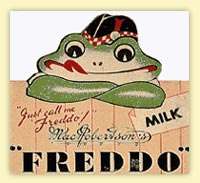
Frogs are eaten, notably in France. One dish is known as cuisses de grenouille, frogs' legs, and although it is not especially common, it is taken as indicative of French cuisine. From this, "frog" has also developed into a common derogatory term for French people in English.[32]
Freddo Frog is a popular Australian chocolate,[33] while frog cake is a Heritage Listed South Australian fondant dessert.[34] Crunchy Frog is a fictitious confectionery from a Monty Python skit of the same name.[35] Chocolate Frogs are a popular sweet in the Harry Potter universe.[36]
See also
References
- 1 2 3 4 Black, Jeremy; Green, Anthony (1992). Gods, Demons and Symbols of Ancient Mesopotamia: An Illustrated Dictionary. The British Museum Press. p. 118. ISBN 0-7141-1705-6.
- 1 2 3 4 Cooper, JC (1992). Symbolic and Mythological Animals. London: Aquarian Press. pp. 106–08. ISBN 1-85538-118-4.
- 1 2 Budge, E. A. Wallis (1904). The Gods of the Egyptians: Or, Studies in Egyptian Mythology. 2. Methuen & Co. pp. 284–286.
- ↑ Smith, Mark (2002). On the Primaeval Ocean. p. 38.
- ↑ Wilkinson, Richard H. (2003). The Complete Gods and Goddesses of Ancient Egypt. Thames & Hudson. p. 107. ISBN 0-500-05120-8.
- ↑ Plutarch. De Herodoti Malignitate, 43, or Moralia, 873f.
- ↑ A. Ludwich (1896).
- ↑

- ↑ Aristophanes, Frogs. Kenneth Dover (ed.) (Oxford: Clarendon Press, 1993), p. 2.
- ↑ The Continuum Encyclopedia of Symbols. Books.google.com. Retrieved 2013-02-17.
- ↑ "Matsuo Bashō's Frog Haiku (Thirty-one Translations and One Commentary)". Bureau of Public Secrets. Retrieved 8 April 2018.
- ↑ Pattanaik, Devdutt (2011-09-08). "Frog in the well". The Times of India. Retrieved 25 June 2013.
- ↑ Zhuangzi, Chapters 秋水 ("The Floods of Autumn") and 至樂 ("Perfect Enjoyment"). Chinese text and James Legge's English translation.
- ↑ Quoted at the end of Embroideries by Marjane Satrapi.
- ↑ Sedgwick, William (July 1888). "Studies From the Biological Laboratory". N. Murray, Johns Hopkins University.
in one experiment the temperature was raised at a rate of 0.002°C. per second, and the frog was found dead at the end of 2½ hours without having moved.
- ↑ "Next Time, What Say We Boil a Consultant". Retrieved 2006-03-10.
- ↑ "Pleasantries". Christian Register. Vol. 101 no. 39. 1922-09-28.
- ↑ "The Frog". American Consular Bulletin. Vol. 4. 1922.
- ↑ "The Frog Round: a Children's Folk Song sung as a Round". Music Files Ltd. Retrieved 2018-03-15.
- ↑ Berrin, Katherine & Larco Museum. The Spirit of Ancient Peru:Treasures from the Museo Arqueológico Rafael Larco Herrera. New York: Thames & Hudson, 1997.
- ↑ "Frog". National Gallery. Retrieved 8 April 2018.
- ↑ Waters, Florence (6 March 2013). "Dead frog painting that rots before your eyes". Daily Telegraph. Retrieved 8 April 2018.
- ↑ Badger, David P. Frogs (S.l.: Voyageur Press, 2001) includes chapters on "frogs in popular culture, their physical characteristics and behavior, and environmental challenges."Are There Fewer Frogs? Archived 11 September 2007 at the Wayback Machine.
- ↑ Mahan, Colin (26 July 2005). "Michigan J. Frog has no leg to stand on". TV.com. Retrieved 4 January 2018.
- ↑ "Characters / The Muppet Show. Kermit the Frog". TV Tropes.org. Retrieved 4 January 2018.
- ↑ "Poliwrath (Pokémon) - Bulbapedia, the community-driven Pokémon encyclopedia". bulbapedia.bulbagarden.net. Retrieved 2018-02-17.
- ↑ "Politoed (Pokémon) - Bulbapedia, the community-driven Pokémon encyclopedia". bulbapedia.bulbagarden.net. Retrieved 2018-02-17.
- ↑ "Seismitoad (Pokémon) - Bulbapedia, the community-driven Pokémon encyclopedia". bulbapedia.bulbagarden.net. Retrieved 2018-02-17.
- ↑ "Greninja (Pokémon) - Bulbapedia, the community-driven Pokémon encyclopedia". bulbapedia.bulbagarden.net. Retrieved 2018-02-17.
- ↑ Furie, Matt (October 13, 2016). "Pepe the Frog's Creator: I'm Reclaiming Him. He Was Never About Hate". Time. Retrieved November 19, 2017.
- ↑ Segal, Oren (September 29, 2016). "Pepe the Frog: yes, a harmless cartoon can become an alt-right mascot". The Guardian. Retrieved November 19, 2017.
- ↑ "Why do the French call the British 'the roast beefs'?". BBC News. 3 April 2003. Retrieved 12 April 2015.
- ↑ "Freddo The Frog creator dies". The Sydney Morning Herald. 29 January 2007.
- ↑ "Protection for frog cake". The Advertiser. 12 September 2001. p. 9.
- ↑ Chapman, Graham; Cleese, John; Gilliam, Terry; Idle, Eric; Jones, Terry; Palin, Michael (1989). Wilmut, Roger, ed. The Complete Monty Python's Flying Circus: All the Words, Volume One. New York, New York: Pantheon Books. pp. 71–73. ISBN 0-679-72647-0.
- ↑ "J.K. Rowling Web Chat Transcript". The Leaky Cauldron. 30 July 2007. Archived from the original on 22 January 2011. Retrieved 30 July 2007.
External links
- The Froggy Page - Frog fun
- History and Lore of the Toad
